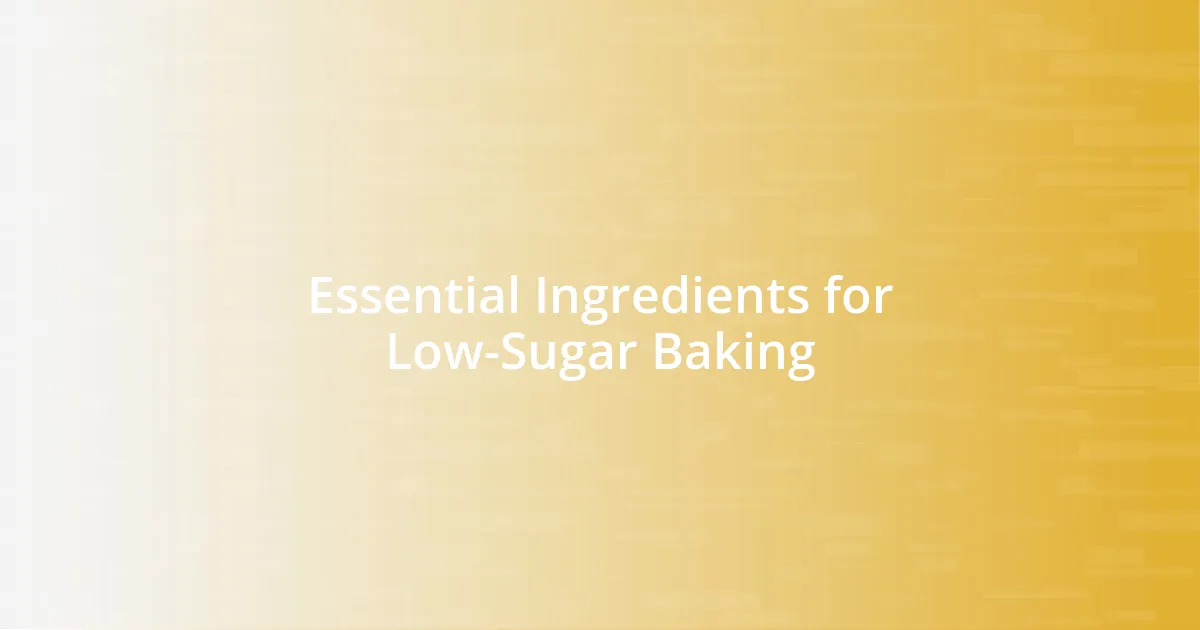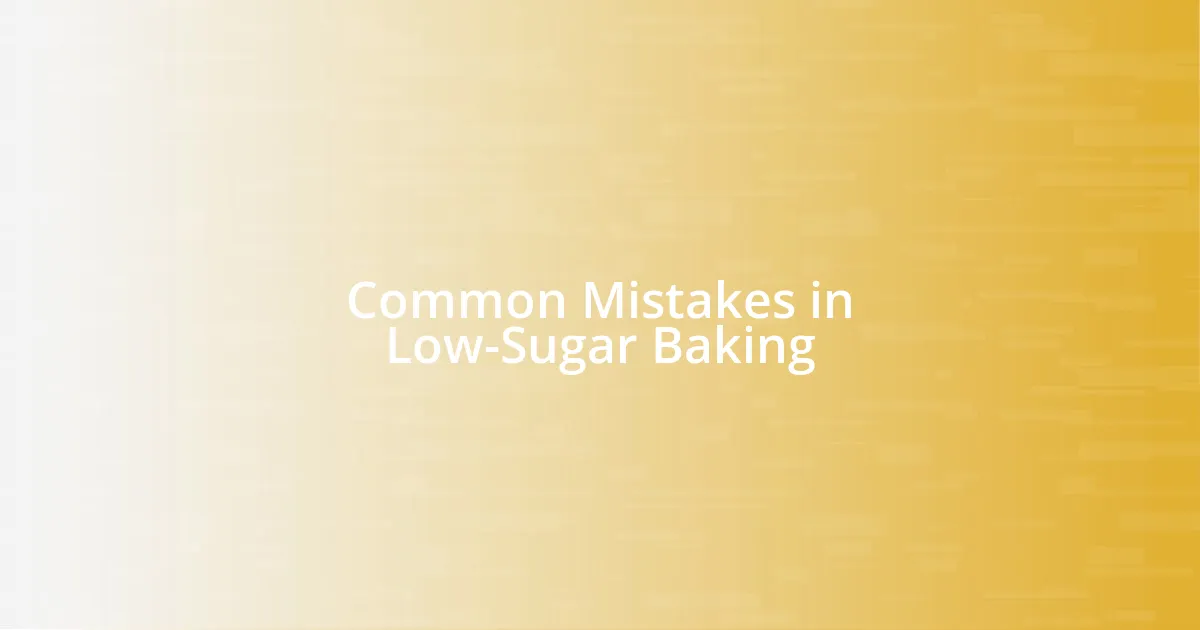Key takeaways:
- Low-sugar baking enhances flavor by using natural sweeteners like applesauce and ripe bananas, along with spices such as cinnamon and vanilla extract.
- Key ingredients for low-sugar baking include almond flour, Greek yogurt, and sugar substitutes like stevia or monk fruit, which can enrich texture and taste.
- Effective techniques to reduce sugar include adjusting baking time and temperature, using unsweetened cocoa, and incorporating nut butters for richness.
- Common mistakes in low-sugar baking involve over-relying on sweeteners, failing to adjust moisture levels, and neglecting flavor enhancers like spices and extracts.

Understanding Low-Sugar Baking
Low-sugar baking can feel like a puzzle at first. I remember the first time I tried to make cookies with half the sugar; I was so nervous they’d turn out bland. But unexpectedly, they had a richness that I wasn’t prepared for, proving that flavor doesn’t solely hinge on sugar content.
When I started exploring alternatives to sugar, I discovered ingredients like applesauce and ripe bananas could transform a dessert. Have you ever used these fruits in baking? The natural sweetness helps maintain moisture while adding subtle flavors that elevate the dish. It’s almost magical to see a simple swap make such a difference!
Another surprise came from using spices like cinnamon and vanilla extract, which enhance sweetness without adding sugar. This discovery shifted my perspective on baking; I realized that crafting a delicious low-sugar treat is not just about reducing sugar, but about amplifying natural flavors, creating a delightful balance that surprises both the palate and the heart.

Essential Ingredients for Low-Sugar Baking
When I first began my low-sugar baking journey, finding the right ingredients felt overwhelming. However, I’ve learned that having a solid foundation of key components can make all the difference. For instance, I love using almond flour. It’s not only low in carbs but also adds a delightful nuttiness that enriches my baked goods. You’d be surprised at how it can elevate the taste and texture of cookies or cakes, giving them a satisfying density.
Here’s a list of essential ingredients that I consider must-haves for anyone venturing into low-sugar baking:
- Almond Flour: Adds richness and moisture.
- Applesauce: A fantastic natural sweetener that also maintains moisture.
- Ripe Bananas: They bring sweetness and a unique flavor profile.
- Greek Yogurt: Provides creaminess and a protein boost.
- Stevia or Monk Fruit Sweetener: Useful for a sugar substitute without the calories.
- Vanilla Extract: Enhances flavor and creates a sweeter perception.
- Cinnamon: Adds warmth and a hint of sweetness.
Incorporating these ingredients has been a game-changer for me. Each one has its own charm and can open up new flavor possibilities, ensuring that my low-sugar desserts not only taste great but also feel indulgent. It’s such a joy to take a bite of something that feels rich and satisfying, all while knowing I made healthier choices.

Techniques to Reduce Sugar Effectively
When it comes to effectively reducing sugar in baking, one technique I’ve found highly effective is adjusting the baking time and temperature. I remember experimenting with baking muffins at a slightly higher temperature for a shorter duration. This approach not only brought out the muffins’ natural sweetness but also helped maintain a moist texture without the need for excessive sugar. It’s fascinating how a small tweak can lead to such rewarding outcomes!
Another strategy I’ve embraced involves using unsweetened cocoa powder or dark chocolate in my recipes. Initially, I hesitated, thinking it might overpower the sweetness I was aiming for. But to my delight, these ingredients added a rich depth that complemented the other flavors beautifully. Have you ever tried baking chocolate desserts with less sugar? You might be surprised by how enjoyable the complex flavors can be when you let the cocoa do the talking.
Lastly, I like to utilize nut butters for both flavor and texture. They not only lend a creamy richness but also create a satisfying mouthfeel that you often seek in desserts. I recall transforming a simple peanut butter cookie recipe to include just a hint of sugar, and the result was a cookie that was both indulgent and surprisingly nutritious. By focusing on enriching the overall experience of the baked goods, it’s possible to enjoy sweet treats while keeping sugar levels low.
| Technique | Description |
|---|---|
| Adjust Baking Time & Temperature | Bake at a higher temperature for less time to amplify natural sweetness and retain moisture. |
| Use Unsweetened Cocoa Powder | Incorporate cocoa for richness, allowing chocolatey depth to replace the need for sugar. |
| Incorporate Nut Butters | Add nut butters for flavor and texture, creating indulgent treats without excessive sugar. |

Flavor Enhancers for Low-Sugar Recipes
Flavor enhancers can truly make a world of difference in low-sugar baking. One of my favorites is vanilla extract—just a teaspoon can brighten any recipe. I remember once making a batch of low-sugar chocolate chip cookies and, despite my doubts, adding extra vanilla took them from bland to a delightful treat that had everyone asking for seconds. Have you experienced the transformative power of vanilla in your baking?
Citrus zest is another magical enhancer I can’t recommend enough. When I add a bit of lemon or orange zest to my low-sugar cakes, it adds a refreshing brightness that lifts the whole flavor profile. I once made a low-sugar lemon poppy seed bread, and that zest brought an unexpected zing that balanced the sweetness perfectly. It’s remarkable how something so simple can make a baked good truly sing.
Herbs and spices are often overlooked, but they can elevate flavors without the need for sugar. I love incorporating fresh rosemary or thyme into my low-sugar muffins. At first, I thought it might be strange, but the earthy notes combined with just a hint of sweetness created a complex flavor that was both surprising and satisfying. Why not experiment with different herbs? You might find a new favorite combination!

Baking Tips for Low-Sugar Success
When baking with less sugar, I always find that enhancing texture is crucial. For example, I enjoy adding ingredients like Greek yogurt or applesauce. Not only do they provide moisture, but they also make the baked goods feel more indulgent. I once made a batch of low-sugar brownies using applesauce instead of most of the sugar, and the result was a fudgy delight that was both satisfying and guilt-free. Have you ever considered using fruit purees in your recipes?
Another tip that has worked wonders for me is using naturally sweet ingredients such as ripe bananas or dates. In my quest for healthier baking, I’ve replaced sugar in muffins with mashed bananas, creating a fragrant and flavorful treat that feels indulgent. The sweetness from the bananas perfectly balances the other ingredients, leaving me with a soft, moist muffin. Did you know how much natural sweetness these fruits can bring to your baked goods?
Lastly, don’t underestimate the power of portion control. I’ve learned that smaller servings can make a big difference. When I cut my brownies into smaller squares, it felt like a treat rather than a guilt-trip. Each small square offered just enough sweetness and left me satisfied, without the compulsion to overindulge. Have you tried adjusting portion sizes in your baking? You might find it’s a simple yet effective way to enjoy your favorite desserts with less sugar.

Common Mistakes in Low-Sugar Baking
One common mistake I often see when people try low-sugar baking is relying too heavily on sweeteners, thinking that simply using a sugar substitute will solve the problem. I remember baking a low-sugar carrot cake and using stevia as a substitute—while the cake looked perfect, the aftertaste was overwhelming. Have you ever had a similar experience where a sweetener just didn’t deliver? It’s crucial to experiment with different options, as each one can impact flavor and texture differently.
Another pitfall is neglecting to adjust the other ingredients. When I first started low-sugar baking, I didn’t realize that reducing sugar impacts moisture levels. I once tried to make low-sugar banana bread, but I didn’t compensate by adding more liquid ingredients. The result? A dry loaf that left me feeling disappointed. Have you ever been disheartened by a recipe that didn’t quite turn out? It’s a learning process, and understanding how sugar interacts with other components is key.
Finally, skipping the seasoning can be a major oversight. I’ve often come across recipes that limit flavor-enhancing spices and extracts when reducing sugar. I learned the hard way that omitting cinnamon from my low-sugar oatmeal cookies made them taste flat. They ended up being a missed opportunity for warmth and depth. Have you noticed how the right spices can elevate flavors? Embracing these elements can truly transform your low-sugar baking into something delightful!

Delicious Low-Sugar Recipes to Try
One recipe that consistently impresses me is my low-sugar berry crisp. I use a blend of fresh berries and a touch of maple syrup, then top it with oats mixed with almond flour and a dash of cinnamon. The result is a warm, comforting dessert that hits all the right notes without being overly sweet. Have you ever noticed how the tartness of berries can bring such a delightful balance to a dish?
Another favorite of mine is low-sugar almond cookies. I substitute most of the sugar with finely ground almonds and a bit of honey, creating a nutty flavor that’s simply irresistible. As they bake, the aroma wafts through my kitchen, making it hard to resist sneaking a taste before they’re fully cooled. If you enjoy a more textured cookie, have you ever thought about experimenting with different nut flours?
Lastly, I can’t recommend my low-sugar chocolate chip banana bread enough. By using ripe bananas to replace the sugar, I not only reduce the sweetness but also infuse a rich, naturally sweet taste that pairs perfectly with semi-sweet chocolate chips. The first time I pulled it out of the oven, my family couldn’t believe it was low-sugar! It was a reminder that satisfaction doesn’t have to come with a hefty dose of sugar. Have you been surprised by how delicious healthy alternatives can be?













